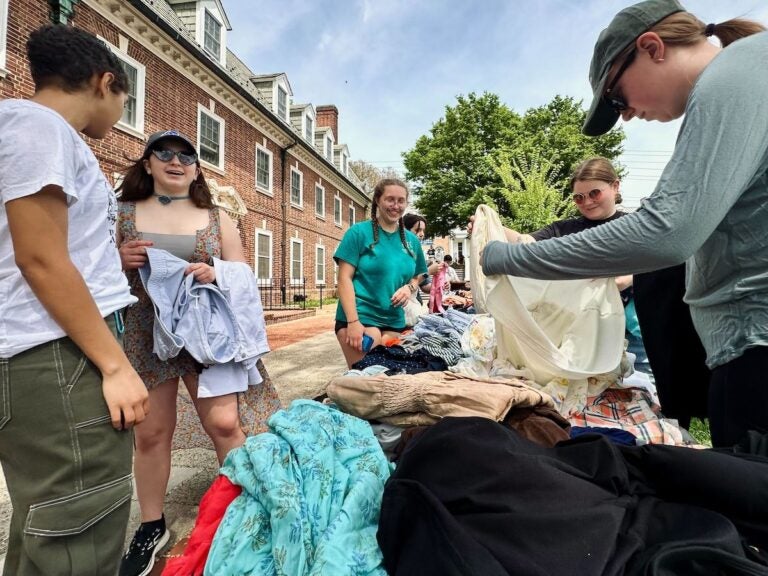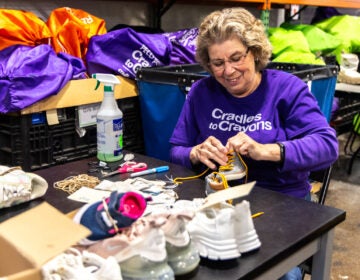Swap, don’t shop: Gen Z leads the charge against fast fashion at University of Delaware clothing event
Delaware students rethink consumer habits at sustainable clothing swap aimed at tackling climate footprint.
Listen 1:28
Students at the University of Delaware gather and sift through clothes during an Earth Day tabling fair, supporting sustainability efforts by donating and swapping clothing at no cost. (Johnny Perez Gonzalez/WHYY)
From Philly and the Pa. suburbs to South Jersey and Delaware, what would you like WHYY News to cover? Let us know!
It wasn’t a shopping spree, it was a mindset shift.
As Brynn Dziemian sifted through tables of secondhand flannels, jeans, athletic wear and denim jackets, she wasn’t just searching for a good find — she was taking a stand.
“Definitely the sustainability,” she said when asked what drew her to the University of Delaware’s clothing swap Friday afternoon in Newark. “I love thrifting. Most of my clothes are all thrifted, I like sorting through all the clothes, I think it’s really fun.”
A kinesiology student from New Jersey, Dziemian is part of a growing wave of Generation Z consumers rejecting fast fashion in favor of slower, more environmentally conscious alternatives. Thrifting isn’t new for her — it’s something she’s done since childhood, thanks to her mom. Now, she’s encouraging her friends to do the same.
“I tell my friends all the time like you got to go to the thrift store, then I’ll take them with me,” she said. “Even the people I surround myself with like they all do it too.”
At the center of this cultural shift is a deeper awareness of fashion’s environmental impact.
“Seeing it in the media, seeing how many companies [produce] fast fashion … everybody kind of piggybacks on that idea and it I don’t know kind of spiraled into something bigger,” Dziemian said, reflecting on the growing visibility of the issue in media and daily life. “You can just thrift the clothing in a more sustainable way.”
A swap for the planet
That’s exactly the kind of shift organizers of the clothing swap hope to entourage. Hosted by the Climate Fellows, a graduate student group focused on environmental justice, the swap invited students to drop off clothes they no longer wanted and pick up something new, all free of charge.
“The fast fashion industry is very destructive for the environment. It’s extremely unsustainable, it’s bad for climate change and it also just can be very wasteful. Clothes just go through factories, they get thrown away, they’re not made thoughtfully,” said Emma Korein, a marine policy graduate student and president of the Climate Fellows. “The industry as a whole can be very damaging for climate change.”
“But a clothing swap is a really cool way to promote reduce, reuse, recycle into the clothing industry,” she added.
For Korein, it’s about making the connection between personal habits and global impact.
She encouraged students to swap clothes “instead of buying a t-shirt from H&M or whatever – I don’t want to single out a single company – stores where clothes are shipped directly from China, which is also part of the climate change impact that you’re putting tons of material on ships and sending it across the ocean. That’s emissions,” she said. “So, instead of doing that, we’re taking clothes from students at UD and giving them to students at UD. There’s no carbon emissions.”
Gen Z’s thrifting power
“I would attribute it to a couple things. One is just an awareness, and it’s almost an awareness to the point where it’s become a trend,” Korein said. “People want to get their clothes sustainably because I feel like back in the day maybe that wasn’t seen as the trendy thing to do, whereas now thrifting is all the rage.”
“I think the other thing is they realize that they’re the ones impacted by climate change. They’re younger, they’re going to live through it,” she added. “And if they don’t do something, they realize that those consequences [will] come back to them in the future. And because of that, they have a motivation to practice sustainable shopping.”
That awareness appears to be translating into action. According to a recent Capital One Shopping report, more than 60% of Gen Z prefer to buy secondhand — a shift shaped by both values and value, especially in an era marked by inflation and rising retail prices.
“Obviously, I’m a single person so it’s a small change, but at least it’s something,” Dziemian said. “When you have cool clothing … and then [people] ask where it’s from and you say you thrifted it, then they get inspired to do the same thing.”
“You’re not going into a store and going to be wearing the same thing as everyone else. It’s very unique to your own style,” she added. “You can really get to experiment, which I think is the most fun part of it.”
Clothes with a second life
Even the leftovers from the swap won’t go to waste. Everything that wasn’t claimed will be donated to Phoenix, a local nonprofit that redistributes clothing to those in need.
“We’re going to donate directly to them and they have systems in place to distribute that,” Korein said. “They take donations and give them back to members of the community. For example, people who don’t have housing or people who are recently unincarcerated or members of the community who are maybe lower income and can’t afford meeting their basic needs of clothing.”
As climate concerns deepen and the popularity of secondhand fashion continues to rise, students like Dziemian and organizers like Korein hope this kind of event becomes more than just a trend and becomes the new norm.

Get daily updates from WHYY News!
WHYY is your source for fact-based, in-depth journalism and information. As a nonprofit organization, we rely on financial support from readers like you. Please give today.







